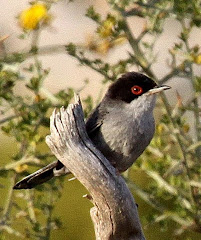
January 5, 2011:
Reports over the last two days of a drake Smew having been seen at Talkin Tarn caused a slight dilemma. Would a round-trip of 200 miles to north Cumbria be justified on the off-chance that the bird would still be there? This locality is rather under-recorded on national birding websites and birders themselves are relatively thin on the ground here so up-to-date information wasn't readily available. However, as the big freeze was abating and the bird likely to be soon gone, it was decided to take a chance and pay a visit.
On arrival things looked distinctly unpromising, no birders present and no sign of the bird either. It's quite a large tarn and, in the biting wind, took a lot of scanning with the scope but other than a nice flock of Goosander there were only the commoner wildfowl and gulls to be seen.
After two hours without success it was time to head back home. Just when leaving Mike arrived so I gave him the bad news and asked him to phone me if he did locate the Smew. Needless to say, when ten miles down the road home, the message came through that two birds had just flown in! So it was back again to the lake to find them swimming conveniently close to the north shore. By now it was almost 3.30 pm and with rapidly fading light and a heavy shower pending, photography was very difficult.


Smew nest in the holes in tree trunks in the taiga forest zone of northern Europe and Asia. Some overwinter along the coasts of the Baltic Sea and northern Germany and Holland and small numbers also sometimes reach Britain, especially in hard weather. This site at Talkin has several previous records for the bird and appears to be especially favoured.


In the late afternoon the two Smew consorted with 20+ much larger Goosanders (also saw-billed ducks) on a small area of unfrozen water where they spent much time diving along the edge of the ice in the impending gloom. They were exceptionally handsome birds and always kept close to each other. On one occasion one climbed out onto the ice to preen whilst the other was briefly put to flight when a Black-headed Gull attacked it. It's quite probable that both of the Smew were commuting between here and nearby Tindale Tarn which would account for their absence earlier in the day.



[Above, some of the 20+ Goosander photographed in better light before the Smew flew in]
So a day which seemed likely to register as blank, finished on a really high note after all.






















































.jpg)



